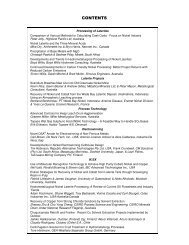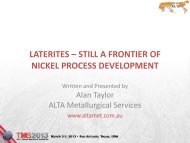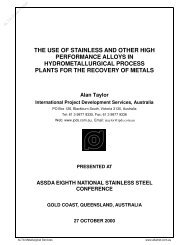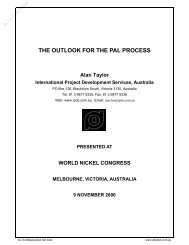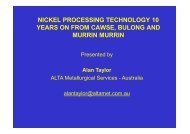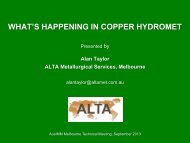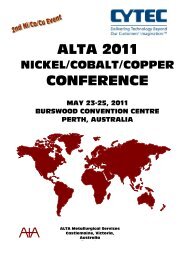solvent extraction mixer-settler design - ALTA Metallurgical Services
solvent extraction mixer-settler design - ALTA Metallurgical Services
solvent extraction mixer-settler design - ALTA Metallurgical Services
You also want an ePaper? Increase the reach of your titles
YUMPU automatically turns print PDFs into web optimized ePapers that Google loves.
<strong>ALTA</strong> Free Paper<br />
SOLVENT EXTRACTION MIXER-SETTLER DESIGN<br />
Alan Taylor & Malcolm L Jansen<br />
International Project Development <strong>Services</strong> Ltd<br />
Blackburn South, Victoria 3130 & North Sydney, New South Wales 2060<br />
Introduction<br />
Abstract – The paper briefly addresses key aspects of the <strong>design</strong> of SX mix<br />
boxes, impellers, <strong>settler</strong>s, piping, materials and other features for<br />
conventional units. Designs such as Krebs, Outokumpu and reverse flow<br />
<strong>mixer</strong>-<strong>settler</strong>s, as well as alternative contactors, are not included.<br />
Mixer-<strong>settler</strong>s were first utilised in the nuclear industry because of their low headroom, which<br />
minimised the amount of shielding required. Other attractive features included simplicity and low<br />
maintenance. Typically, the nuclear <strong>mixer</strong>-<strong>settler</strong>s consisted of partitioned “boxes” to avoid interstage<br />
piping, and relied on density differences to provide driving force for liquid flows. Since then, the use<br />
of <strong>mixer</strong>-<strong>settler</strong>s has spread to a wide range of applications, and they continue to enjoy favour in the<br />
mining and metallurgical industry due to their simplicity, ease of operation, stability under a wide<br />
range of flows, accessibility for clean-out and reliable scale-up. Their versatility is demonstrated by<br />
their application to small multi-stage installations, such as for rare earths, through to very large scale<br />
plants for copper recovery. Consistent effort has been made to improve efficiency and reduce capital<br />
and operating costs of the basic <strong>design</strong>. This has led to the development of new <strong>design</strong>s, some of<br />
which have been commercialised. This paper focuses only on the conventional <strong>design</strong>. Space<br />
necessarily limits the amount of detail presented. References with more detailed information are<br />
given.<br />
Basic Design Concepts<br />
In its simplest form, a <strong>mixer</strong>-<strong>settler</strong> consists of an agitated tank (<strong>mixer</strong> or mix box) in which the<br />
aqueous and organic solutions are contacted, followed by a shallow gravity settling basin (<strong>settler</strong>)<br />
where the solutions disengage into individual layers for separate discharge. Multiple mix boxes may<br />
be used of either cylindrical or rectangular shape, depending on the desired retention time, capacity,<br />
materials of construction and site layout. The <strong>settler</strong> may also be cylindrical or rectangular, though<br />
rectangular is most commonly used in order to provide a more compact layout, and to minimise<br />
interstage piping runs.<br />
A typical arrangement is shown in Figure 1, which consists of two cylindrical mix boxes and a<br />
rectangular <strong>settler</strong>. The mix boxes are configured in-line, though an “L” shaped arrangement is also<br />
often used. The number of mix boxes usually lies in the range of one to three. One is suitable for<br />
small plants using extractants with rapid kinetics. Two or three stages are more applicable to larger<br />
plants and longer mixing times. In this particular <strong>design</strong>, the mix boxes are separate vessels joined by<br />
a launder. In other arrangements, especially for large operations, the mix boxes may be formed by<br />
subdividing a single rectangular construction, which eliminates the connecting launder. In some cases,<br />
they have been made part of the <strong>settler</strong>. The first mix box is shown with a pump-mix type of impeller,<br />
which provides head for interstage pumping of the solutions as well as mixing the two phases.<br />
External interstage pumps have generally been avoided because of the risk of creating permanent<br />
emulsions leading to high residual entrainment levels leaving the <strong>settler</strong>s. The second mix box is<br />
fitted with a mixing impeller <strong>design</strong>ed for maximum mixing efficiency with minimum shear. The<br />
agitators are commonly equipped with variable speed drives to allow the optimum speeds to be<br />
determined during commissioning and subsequent operation. The <strong>settler</strong> is equipped with a full width<br />
distributor to spread the flow evenly across the width. This is followed by a picket fence, which
<strong>ALTA</strong> Free Paper<br />
serves to dampen solution movement and act as a supplementary distributor. Some <strong>design</strong>ers<br />
eliminate the distributor and rely solely on a picket fence. Others add a second or even third fence for<br />
some applications. The authors consider a well <strong>design</strong>ed distributor to be highly advantageous. Full<br />
width organic and aqueous weirs are shown to minimise the discharge velocities. The aqueous<br />
discharge weir box is fitted with a secondary (advance) weir to facilitate the separation of a portion of<br />
the aqueous flow for recycle to the mix box. This may not be required in some cases, and in others it<br />
may be necessary to provide an advance weir in the organic weir box, or even in both boxes. It is<br />
recognised that some <strong>design</strong>ers use other recycle arrangements, but the authors have found this<br />
particular concept to be successful and easy to operate. By giving the recycle “first bite” of the<br />
solution, it provides a constant hydraulic head for the recycle stream, which can otherwise be difficult<br />
to control. The solution leaves the <strong>settler</strong> via the advance weir box, which provides limited surge<br />
capacity for flow variations. All of the discharge pipes are fitted with manual control valves. It is<br />
good <strong>design</strong> practice to install a simple vortex breaker at the inlet to each discharge pipe. Generally,<br />
the discharge pipes are connected to the bottom of the weir boxes to avoid air entrainment, which can<br />
lead to crud formation and increased entrainment losses.<br />
Mix Box Details<br />
The required overall retention time is set by testwork, the extractant supplier’s recommendation and<br />
industry practice. Typically, it varies from 1 to 5 minutes. The mix boxes are <strong>design</strong>ed to provide this<br />
under dynamic operating conditions. This means that the operating crest on each mix box and the<br />
volume in the downcomer (or upcomer in some <strong>design</strong>s) is included. Commonly the mix boxes are<br />
<strong>design</strong>ed with the same external dimensions for ease of construction, though some <strong>design</strong>ers prefer to<br />
use a smaller first box. The height of each box is generally minimised to reduce construction costs,<br />
though this may not be important for smaller plants. Care must be taken in setting the active solution<br />
height to avoid vortexing and air entrainment. Typically, a minimum aspect ratio (active height to<br />
vessel diameter) of about 0.6 is employed. Adequate freeboard must be allowed in each mix box to<br />
account for the crest heights, which depend on the mix box dimensions and the pressure drop through<br />
the system.<br />
In Figure 2, the first box is fitted with a false bottom to which the organic and aqueous feed and<br />
recycle pipes are connected. The aqueous and organic must be kept separate by installing dividers in<br />
the false bottom, otherwise the organic flow will be hindered due to its lower density. If the recycle<br />
line is <strong>design</strong>ed for dual use (ie aqueous or organic), it must have its own separate compartment in the<br />
false bottom. Some <strong>design</strong>ers use a “boot” protruding below the base of the mix box, instead of a<br />
false bottom. This may be an extension of an internal draft tube, which is used in some installations.<br />
In another variation, especially where the piping is of very large diameter, the false bottom is extended<br />
up the sides of the mix box in order to provide sufficient area for the pipe connections. Following<br />
conventional mixing <strong>design</strong> practice, vertical sidewall baffles are used to promote proper mixing<br />
patterns. Each box is fitted with a horizontal baffle at the top overflow port to reduce short-circuiting.<br />
Sometimes anti-vortex baffles are installed near the top of the first mix box, especially when the<br />
pump-mix impeller is mounted higher up the vessel in conjunction with a draft tube. The dispersion<br />
formed in the first mix box enters the second stage via a downcomer to avoid short-circuiting. In<br />
some <strong>design</strong>s, the downcomer is mounted in the first mix box. In comparing various <strong>design</strong>s, it should<br />
be recognised that the <strong>design</strong> features are often influenced by the preferences of the <strong>design</strong>er, as well<br />
as by plant layout and materials of construction issues.<br />
A variety of pump-mix impeller <strong>design</strong>s have been used over the years. As plants initially grew<br />
larger, especially for copper SX, the applications lay outside of the experience of the equipment<br />
suppliers, and the impellers were generally specified by engineering firms and consultants. The most<br />
common <strong>design</strong> was the single shrouded type with six radial straight blades mounted over a cylindrical<br />
hole at the bottom of the mix box (which became known as the General Mills impeller). The other<br />
common type was the double shrouded type with eight radial swept-back curved blades, usually<br />
elevated to about one third of the liquid depth and fed by a draft tube (Davy BB impeller). Key issues<br />
are to provide adequate pumping head and mixing power, while minimising the formation of fine
<strong>ALTA</strong> Free Paper<br />
droplets, which can lead to entrainment losses. For auxiliary impellers for the second (or third) stage,<br />
standard up pumping low shear mixing types have generally been specified. In recent years the<br />
equipment supplier Lightnin has undertaken extensive hydraulic test and modelling work to compare<br />
different impeller types, out of which they have developed new pump-mix and auxiliary impeller<br />
<strong>design</strong>s, which have since been widely used. A significant outcome is their ability to select the<br />
recommended optimum <strong>design</strong> for each particular application, including the feed hole diameter and<br />
clearance between the impeller and the bottom of the mix box in the case of pump-<strong>mixer</strong>s. A vital part<br />
of mix box <strong>design</strong> is the minimisation of the head required to be developed by the pump-mix impeller.<br />
Although it has the great advantage of operating as a self-regulating device over a wide range of<br />
flowrates, the pump-<strong>mixer</strong> has a low head capability. Thus, the <strong>design</strong> head must be carefully<br />
estimated and specified to the impeller supplier before finalisation of the mix box <strong>design</strong>, in case<br />
adjustments are required.<br />
Settler Details<br />
The <strong>design</strong> settling area is generally specified from industry experience supplemented by testwork as<br />
appropriate. Specific settling area can typically vary from 2 to 6 m 3 /h/m 2 over a temperature range of<br />
10 to 40 0 C, and is affected by factors such as the type of extractant, extractant concentration, O/A ratio<br />
and the phase continuity. An important issue is the minimum operating temperature, as the phase<br />
disengagement rate is highly sensitive to temperature, particularly below 20 0 C. At the other extreme,<br />
the maximum temperature is determined by organic degradation considerations, and is typically<br />
around 40-45 0 C. The shape of the <strong>settler</strong> is determined by specifying a width based on an organic<br />
velocity within the range of 3-6 cm/sec, derived from industry experience. Above this range, there is a<br />
risk of excessive turbulence at the weirs, while lower velocities can result in uneven flow patterns<br />
across the <strong>settler</strong>. Designers vary in their practice but, from a cost point of view, it is usually<br />
advantageous to adopt a narrower <strong>settler</strong> to reduce the cost of the distributor, picket fence, weir boxes,<br />
interstage piping and roof. The authors have had consistent success at the upper end of the velocity<br />
range. Of course, the velocity is also dependent on the depth of the organic layer. This is usually set<br />
as low as possible to minimise the volume of the organic inventory, which is frequently a high cost<br />
item. It is commonly within the range of 150-300 mm, and can be varied by adjusting the height of<br />
the aqueous weir. The organic weir is normally fixed, and sets the overall static depth of liquid. The<br />
<strong>settler</strong> sidewall height is normally about 1m, which allows for a freeboard of around 200 mm, plus<br />
adequate depth for the dispersion band, aqueous layer, and a clearance under the aqueous weir in the<br />
range of 100-200 mm. Some <strong>design</strong>ers have opted for a slope down under the aqueous weir box in<br />
order to reduce the depth in the main portion of the <strong>settler</strong>. In some cases, the available site area can<br />
have an overriding effect on the shape of the <strong>settler</strong>s.<br />
Figure 2 shows an inlet distributor consisting of a full width launder fitted with a series of holes in the<br />
bottom. The authors have found this to be effective for “killing” the velocity of the incoming<br />
dispersion, and achieving a good distribution across the <strong>settler</strong> width. It may be advantageous to cover<br />
the centre portion of the launder to avoid splashing of solutions over the top into the <strong>settler</strong> and the<br />
environment above. A variation of this concept is the use of a HDPE pipe in lieu of the launder, which<br />
is particularly advantageous if the <strong>settler</strong> is lined with the same material. It is recognised that many<br />
other <strong>design</strong>s have been used. The distributor is followed by a conventional picket fence, consisting of<br />
two rows of slats mounted offset to force the liquids to go through several 90 0 direction changes on the<br />
way through, as illustrated in Figure 4. Because of the effective operation of the distributor, the fence<br />
can be of the low head type. As mentioned above, some <strong>design</strong>ers opt for no distributor; in which case<br />
the picket fence must be <strong>design</strong>ed for a higher pressure drop in order to achieve effective distribution.<br />
This type of fence is sometimes <strong>design</strong>ed as a chevron, which provides more stilling area immediately<br />
in front of the feed from the mix box. Typically, the inlet portion of the <strong>settler</strong>, with the distributor<br />
and picket fence, is regarded as part of the active <strong>settler</strong> area.<br />
In the <strong>design</strong> shown in Figure 3, the separated aqueous passes under the organic weir box on its way to<br />
the aqueous weir box. However, when a plastic lined construction is used for the <strong>settler</strong>, it may be<br />
preferable to use a “drop-in” one-piece weir box assembly, supported from the <strong>settler</strong> walls or from
<strong>ALTA</strong> Free Paper<br />
external members without compromising the integrity of the lining. In such an arrangement, the<br />
organic and aqueous weir boxes are constructed back to back, and the aqueous passes underneath both<br />
boxes then flows up and over the aqueous weir in the reverse direction, as shown in Figure 5. The<br />
length of each weir box is generally specified to accommodate the connection of the discharge piping.<br />
In the case of the “drop in” <strong>design</strong>, the weir boxes may be extended beyond the <strong>settler</strong> side walls to<br />
enable the bottom connection of the discharge piping without penetrating the plastic lining of the<br />
<strong>settler</strong>. Various <strong>design</strong>s have been utilised for the adjustable aqueous weir mechanism. A key issue is<br />
to eliminate leakages through any joints, which can lead to the undesirable migration of liquids when<br />
the flows are stopped. The range of adjustment is set to produce the desired variation in organic layer<br />
depth. The discharge weir boxes are not considered to be part of the active area of the <strong>settler</strong>. It is<br />
recognised that other liquid discharge arrangements have been used, including taking the organic or<br />
aqueous recycle stream from the main body of the <strong>settler</strong>, thus significantly reducing the length of the<br />
recycle piping. This could be adequate, for example, for small or intermittent recycle flows.<br />
Piping Design<br />
A key consideration is the pressure drop through the interstage piping, which must be minimised to<br />
keep the pumping head to be developed by the pump-<strong>mixer</strong>s within acceptable limits. This normally<br />
requires low pipe <strong>design</strong> velocities, in the order of 1 m/sec, which can result in large pipe diameters,<br />
especially for high capacity installations. Other important issues include the reduction of pipe lengths,<br />
minimisation of bends, and careful arrangement of pipe runs and valves for ease of operation and<br />
maintenance. This should involve evaluation of various layouts for the entire SX circuit and<br />
associated tankage in relationship to associated plant areas, looking at all major pipe runs and<br />
connections to the mix boxes and weir boxes. Recycle pipes usually need particular attention, and<br />
may require the construction of trenches or pipe way tunnels in some instances. Drainage/refill and<br />
crud removal piping for the <strong>mixer</strong>-<strong>settler</strong>s also need careful planning, especially if gravity drainage is<br />
to be used. Time spent at this stage is paramount in obtaining a well layed out, cost effective overall<br />
plant <strong>design</strong>. Standard piping <strong>design</strong> criteria can normally be applied to pumped lines. One very<br />
important consideration is the accessibility of the manually actuated valves on the interstage and<br />
recycle pipes from the upper level walkways near the <strong>settler</strong> discharge weirs without having to<br />
descend to ground level. These valves are frequently used to maintain consistently high levels in the<br />
weir boxes under varying flow conditions, to avoid air entrainment. They may also have to be closed<br />
on plant shutdown. This facility may require the fitting of long stem valve actuators.<br />
Other Design Considerations<br />
A vital aspect of <strong>mixer</strong>-<strong>settler</strong> <strong>design</strong> is the elevation and support of the <strong>settler</strong>s, which have major<br />
implications for overall plant layout, piping <strong>design</strong>, capital cost and access for operation and<br />
maintenance. Three alternative concepts are illustrated in Figure 6. In the first, the <strong>settler</strong>s are at<br />
ground level, and the interstage piping is located in trenches covered by grating or concrete slabs,<br />
while the valve actuators are at operator level to provide ready access. This is a particularly<br />
convenient arrangement for operators; however it is most suitable when the site topography allows the<br />
associated tanks and pumps to be located at a lower level to accommodate gravity flow from the<br />
<strong>mixer</strong>-<strong>settler</strong>s. Good examples include large copper SX plants located in mountainous terrain the<br />
Western USA. For a flat site, this arrangement will involve significant excavation, which can be<br />
prohibitive. The other two concepts involve the elevation of the <strong>settler</strong>s on fill or concrete, steel or<br />
wooden supports, and are more applicable to flat sites. Generally the determining factor is the capital<br />
cost, which is affected by ground conditions and the price of local materials. With the fill option,<br />
tunnels through the fill or interstage trenches are required for some of the recycle pipes. The various<br />
options should be carefully evaluated early in the <strong>design</strong> phase.<br />
The provision of walkways is particularly important, and should be developed with experienced<br />
operating input. Key areas include the top of the mix boxes, and the <strong>settler</strong> picket fences and<br />
discharge weir boxes. For indoor installations, <strong>mixer</strong>-<strong>settler</strong>s are normally covered to avoid organic<br />
evaporation losses and to protect against dust, insects and wind turbulence. Suitably located sampling<br />
and inspection hatches must then be installed. It is common practice to provide open area or large
<strong>ALTA</strong> Free Paper<br />
hatches above and immediately in front of weir boxes to facilitate manual crud removal and<br />
adjustment of the aqueous weir.<br />
The materials of construction can have a significant impact on the <strong>mixer</strong>-<strong>settler</strong> <strong>design</strong>, and therefore<br />
must also be addressed early. For example, the selection of HDPE lined concrete can lead to the<br />
adoption of a “drop-in” weir box <strong>design</strong>. HDPE has been selected as a cost effective material for<br />
large-scale copper SX facilities, especially when the presence of chloride renders 316 SS unsuitable.<br />
For smaller plants, self-supporting FRP has been widely used, and has the advantage of allowing shop<br />
fabrication and shipment to site, whole or in segments. Other materials commercially applied over the<br />
years include concrete lined with thin gauge stainless, FRP or epoxy-sand mix, steel lined with PVC or<br />
epoxy, FRP–balsa sandwich and even wood.<br />
Fire protection measures vary from plant to plant depending on the requirements of the insurance<br />
underwriters. The best fire protection measure is the use of a high flashpoint diluent for the organic,<br />
which results in a relatively low fire risk, and allows some installations to be equipped with very<br />
simple water based fire fighting systems. Others have adopted manually operated or automatic foam<br />
based systems. If foam is to be used, it should be AFFF (Aqueous Film Forming Foam) which, unlike<br />
some other foams, does not permanently damage the expensive organic liquid. Other <strong>design</strong> features<br />
include gaps between adjoining <strong>mixer</strong>-<strong>settler</strong>s (which can be used for walkways) and, in extreme<br />
cases, firewalls separating groups of <strong>mixer</strong>-<strong>settler</strong>s. Surrounding pad areas and trenches should drain<br />
to a safe location, and sumps should overflow into the same drainage system.<br />
Conclusions<br />
The <strong>design</strong> of conventional <strong>mixer</strong>-<strong>settler</strong>s for the separation and <strong>extraction</strong> of metals is now well<br />
established and proven over a very wide range of capacities. However, details vary according to the<br />
particular application, the materials of construction and the preference of individual <strong>design</strong>ers. Overall<br />
plant layout and piping <strong>design</strong> are affected by site characteristics, materials of construction and local<br />
cost factors. Fire protection measures are generally driven by the requirements of the insurance<br />
underwriters.<br />
References - Conventional Mixer-Settlers<br />
Taylor, A., 1997, - Copper SX/EW Seminar: Basic principals, Alternatives, Plant <strong>design</strong>. <strong>ALTA</strong><br />
<strong>Metallurgical</strong> <strong>Services</strong> Publication.<br />
Jansen, M. L., Taylor, A, 1997 – Solvent Extraction Mixer-Settlers and Contactors: Developments and<br />
Trends. <strong>ALTA</strong> 1997 Copper Hydrometallurgy Forum Proceedings.<br />
Giralico, M. A., Post, T.A., Greaves, M. C., Stevenson, E., 1998 - Introducing LIGHTNIN’s<br />
Integrated SW/EW Mixer-Settler Unit. <strong>ALTA</strong> 1998 Copper Hydrometallurgy Forum Proceedings.<br />
Other Designs<br />
Hopkins, W. R., 1996 – Reverse Flow Mixer Settlers. <strong>ALTA</strong> 1996 Copper Hydrometallurgy Forum<br />
Proceedings.<br />
Nyman, B., et al, 1998 – The Outokumpu Copper Solvent Extraction Process – An Approach Based on<br />
Interactions Between Running Parameters and Mixer-Settler Design Introduced at Radomiro Tomic<br />
VSF SX Plant in Chile. <strong>ALTA</strong> 1998 Copper Hydrometallurgy Forum Proceedings.<br />
Williams, R. L., Sonntag, A. A., 1995 – Krebs And Solvent Extraction. <strong>ALTA</strong> 1995 Copper<br />
Hydrometallurgy Forum Proceedings.<br />
Buchalter, E. M., Kleinberger, R., 1998 – Copper Solvent Extraction using a Bateman Pulse Column.<br />
<strong>ALTA</strong> 1998 Copper Hydrometallurgy Forum Proceedings.
<strong>ALTA</strong> Free Paper
<strong>ALTA</strong> Free Paper<br />
<br />
<br />
<br />
<br />
<br />
<br />
<br />
<br />
<br />
<br />
<br />
<br />
O<br />
A<br />
<br />
NO. 1 MIX BOX<br />
NO. 2 MIX BOX<br />
NOTE:<br />
False bottom divided into organic and aqueous compartments.<br />
Orientation of divider varies with piping layout, including aqueous<br />
recycle.
<strong>ALTA</strong> Free Paper<br />
<br />
<br />
<br />
<br />
<br />
<br />
<br />
FEED END<br />
<br />
ELEVATIONS<br />
<br />
<br />
<br />
<br />
<br />
<br />
<br />
<br />
<br />
<br />
<br />
<br />
DISCHARGE END<br />
<br />
PLAN VIEW OF<br />
DISCHARGE<br />
END
<strong>ALTA</strong> Free Paper<br />
<br />
<br />
<br />
<br />
ELEVATION<br />
<br />
<br />
PLAN VIEW
<strong>ALTA</strong> Free Paper<br />
<br />
<br />
<br />
<br />
<br />
<br />
<br />
<br />
GROUND LEVEL<br />
<br />
ELEVATED ON FILL<br />
<br />
ELEVATED ON STRUCTURE



